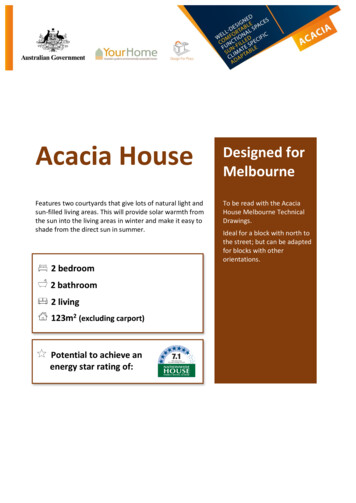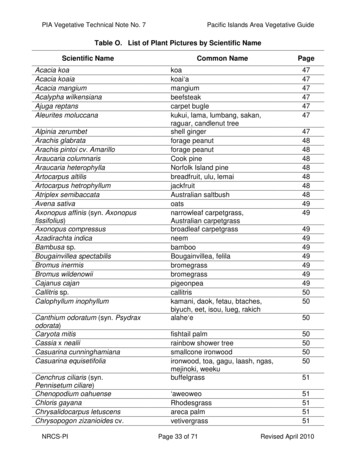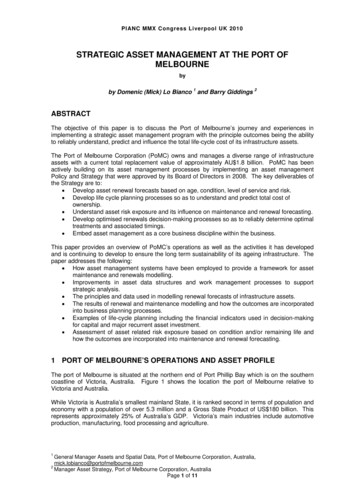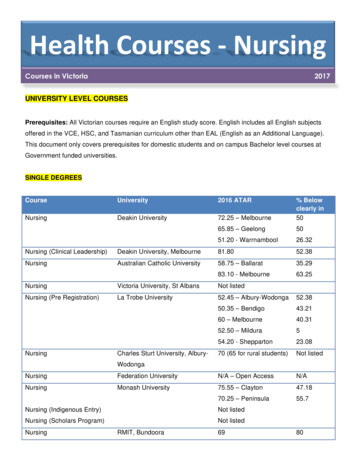
Transcription
Acacia HouseDesigned forMelbourneFeatures two courtyards that give lots of natural light andsun-filled living areas. This will provide solar warmth fromthe sun into the living areas in winter and make it easy toshade from the direct sun in summer.To be read with the AcaciaHouse Melbourne TechnicalDrawings.2 bedroom2 bathroom2 living123m2 (excluding carport)Potential to achieve anenergy star rating of:Ideal for a block with north tothe street; but can be adaptedfor blocks with otherorientations.
How to use these design optionsThese design packs provide an example of what a well-designed, sustainable house might look like. Italso gives you information to support your discussions with architects, designers or builders.The Acacia house provides a best practice example to help you apply energy-efficient designprinciples to your home. It offers construction detail options for the Acacia house, as well as asnapshot of key principles to consider when designing a sustainable home.The Acacia house has been designed by an architect in collaboration with an energy assessor, and isready to use or can be adapted to best suit your climate, block and orientation.Your architect, designer or builder can help you tweak these plans to meet your needs. You couldalso use the Acacia house design options to: develop a concept for your own design brief to take to an architect, designer or builder incorporate design features into your house design or renovation understand key principles to consider when designing a sustainable home consider how to adapt the specifications for your climate and local requirements.Acacia House street viewMelbournePage 2
Energy star ratingsThe Nationwide House Energy Rating Scheme(NatHERS) is a star rating system that measuresthe energy efficiency of a home, using keyfeatures of the home, including the design,orientation, materials and climate. A NatHERSrating is the most common method used toshow that a new home complies with theminimum energy efficiency requirements in theNational Construction Code.An energy assessor calculates the star ratingusing a NatHERS software tool to determine thethermal performance of a home. Assessors aregenerally engaged by the architect, designer orbuilder on your behalf, but engaging an assessorearly in the process will help you adapt yourdesign to get the best outcome.Your home will need to be rated by an energyassessor based on its exact location, design andbuilding specifications, even if you decide not toalter the Acacia house. Any changes to theAcacia house specifications or drawings willaffect your energy rating. By engaging anassessor early, they can help you compareoptions before decisions are locked in.Benefits of a higherenergy star ratingA 6 star rating is the minimum standard in moststates and territories, however aiming for ahigher energy star rating can have significantbenefits to the comfort and cost of running yourhome.Homes with higher energy ratings rely less onheating and cooling systems. Less energy usemeans lower energy bills. Aiming for a high starrating can help you get a home that’s cheaper torun and more comfortable to live in.On average, a 7 star home in Melbourne ispredicted to use 27% less energy for heating andcooling compared to a 6 star home. And an 8star home is predicted to use a massive 53% lessenergy.Below are two examples for Melbourne basedon the Acacia house design and specifications.The Acacia house 7.1 requires 28% less energy1 than a 6 house.Predicted energy use for heating and cooling120100Mj/m280604020016 6.1 6 7.1 Predicted annual energy use for heating and cooling of the Acacia House Melbourne design and specificationsMelbournePage 3
Design featuresThe Acacia house design offers a home withdesirable features such as; Optimises eaves and shading devices forsummer shade, while allowing in winter sun- Includes burnished concrete floor forgreater thermal mass Has living areas open to outdoor spaces withconnection to the yard Provides a functional floor plan withminimal circulation space. The compacthouse size reduces construction andoperating costs to heat and cool Simple layout of rooms to support ease ofconstruction and reduce build costs Has doors to separate rooms and provideszoned internal spaces, so you can heat andcool only the rooms you need Includes a carport with storage space thatcan be converted to a garage, or extendedto a double carport or garage if space allows Approximately 170m2 roof space availablefor solar panelsgenerous ceiling heights of 2.7mpractical bathroom and laundry layoutsopen plan kitchen-dining and separateliving areagenerous-sized bedrooms suited to fit aqueen bedThe design also incorporates sustainabilityprinciples and considerations to maximiseenergy efficiency and comfort.The Acacia house design: Provides a great outcome for a small blockwith north to the street Is positioned away from the front boundaryfor a usable north-facing front yard Offers two courtyards to provide naturallight and winter sun to fill all rooms Embraces windows sized and positioned forsolar orientation, natural light and crossflow ventilationSee Acacia House Melbourne Technical Drawings for detailed floor planVisit YourHome.gov.au for detailed information on key sustainable design principlesMelbournePage 4
Building specificationsThe building specifications outlined below show what construction materials you will need to helpyou reach the star rating goal that best suits you. Discuss these options with your architect, designeror builder, so they can customise it to suit your needs. For a well-designed house, often thedifference between the options listed below do not cost significantly more, and can result in longerterm savings and comfort.These construction details have been optimised for the Acacia house designed for Melbourne.Construction detailsFloor100mm concrete slab with 300mm waffle pod6.1 7.1 100mm concrete slab on ground with R1.8 under slab insulationFinishes: Burnished concrete to living areas, carpet to bedrooms, ceramic tilesto wet areas Ceiling10mm plasterboard on timber framing with R5.0 batt insulation RoofMetal sheet roofing on timber battens with R1.5 reflective foil laminate 1000mm eave overhang 600mm eave overhangExternal wallsLightweight cladding on battens, reflective foil membrane (vapour permeableif appropriate), timber frame, R2.5 batt insulation, 10mm plasterboard Internal walls10mm plasterboard on timber framing with R2.5 batt insulation WindowsDouble glazed, thermally broken aluminium frame Double glazed, uPVC frameDraughtsealingWeather strips to all windows and sliding doors. Seals and weather-strips tohinged external doors. Sealed exhaust fans to bathroom, powder room andkitchen rangehood. Ceiling fans1400mm diameter fans. 1 in each bedroom, 1 in the dining area, 1 in the frontliving area. General Notes- uPVC (unplasticised polyvinyl chloride) window frames have similar insulating properties to timber frames.- Insulation is often measured as an R value – a measure of resistance to heat through a specific thickness of a material.Higher values indicate better insulating properties.- Reverse brick veneer places the brickwork on the inside of the building rather than the outside. It can increase the thermalmass performance, however is less common in practice compared to conventional brick veneer and can be more costly.- Burnished concrete allows maximum thermal mass, and works particularly well in cool locations. For the thermal mass of aconcrete slab to work effectively, it must interact with the house interior to absorb heat, and be used in conjunction withgood passive design. Covering the slab with finishes such as carpet, reduces the effectiveness of the thermal mass.MelbournePage 5
Windows and doorsShadingWindows and glass doors can be a majorsource of heat gain in summer and heat loss inwinter. Up to 87% of a home’s heat can begained, and up to 40% of its heat lost, throughwindows and glass doors. Improving thethermal performance of windows reducesthese heat gains and losses, and reducesenergy costs. The building specifications onthe previous page show an example of theimpact of different frame and glass types.Shading can make a big difference to yourcomfort and energy use. In summer and inwarmer climates, external barriers like eavesand sunshades can be used to block the sunfrom entering windows. In winter and incolder climates, shading can be reduced toallow the sun to naturally warm your home.Good design will use shading to optimise orlimit solar access for your specific climate.Generally, windows and glass doors transferheat faster than a well-insulated wall. This isone of the reasons why the type of glazing hasa massive impact on an energy rating. Otherconsiderations include optimising glazing tofloor area ratios for each room and adequateshading.The estimated NatHERS star ratings on theprevious page are based on generic windowperformance values - your architect, designeror builder can tell you what products areavailable to match the window specifications.Engaging an energy assessor as soon as yourwindow selection has been made, or evenbetter, working with an energy assessor onyour window selection and optimisation, willensure you achieve the best outcome in yourhome.Northern sides of your home benefit mostfrom fixed shading such as eaves and awnings.When they are designed well, the shading canself-regulate solar access throughout the yearwithout requiring any user effort.Adjustable shading that is vertical, such asexternal blinds or screens, are oftenrecommended for the eastern and westernsides of your home. This is because the sunrises and sets at lower angles in the sky on theeast and west, and horizontal shading fromeaves and awnings will generally not keep thesun out. Shade cloth and deciduous plantingcan also be used to provide self-adjustingseasonal shading.The Melbourne Acacia house 7.1 design hasthe eaves reduced to 600mm. This has beenoptimised for adequate summer shadingwhile still allowing solar heat gain in winter.See the technical drawings for window sizesand types which have been optimised for theMelbourne climate.Concept sketches of key principles - northern exposure for pleasant outdoor spaces, various featuresused to shade windows from the summer sun and courtyards added for maximising solar accessMelbournePage 6
Heating, cooling and appliancesVery little energy is needed to make a well-designed house comfortable. Appropriate insulation,which is essential for a comfortable house, combined with passive solar design and a home sealedfrom unwanted draughts, can create low or even no energy requirements for heating and cooling.When choosing heating and cooling appliances, consider options that allow you to heat and cool onlythe occupied areas of your home. Fans are an excellent choice for cooling in a well-designed home.Typically, the air flow created by a fan provides a similar improvement to comfort as reducing thetemperature by around 3 C.Choosing a correctly sized system is also very important, as is careful consideration of its positioning.An undersized system will need to work hard for longer and therefore not be as efficient, and anoversized system will be using more energy than needed. Expert advice is recommended.Most heating and cooling systems have Energy Rating Labels to help you choose the most efficientmodel. For efficient space conditioning (ie. reverse cycle air conditioner), the house should be sealedand insulated, with windows shaded from the summer sun or covered with curtains and pelmets tokeep winter warmth in.Careful selection of appliances can also save money and reduce your environmental impact withoutcompromising lifestyle. The key appliances of higher energy use include fridge freezers, cooking, andTVs. Consider the lifetime costs of energy efficient appliances not just the purchase cost. Energyefficient appliances can save you hundreds of dollars each year in running costs. The Energy RatingLabel is mandatory for many household appliances and can help you choose an efficient appliance.Although heating and cooling systems, and appliances, are not included in NatHERS star ratings, it isimportant to incorporate these into your design process, to achieve your energy efficient home.Talking to your designer or builderUse the information on the following page to guide your conversations with architects, designers orbuilders, to help you get the most out of your Design For Place project. Talk to a few to find one thatbest suits your needs and ask for references from their clients.Consider your needsTake some time to consider your needs, including likely changes to your lifestyle over time. Thinkabout how you use the spaces in your current home. Prioritise these, and weigh up whether morespace will deliver the best outcome over time. In many cases a smaller but well-designed, flexiblespace is more practical and better able to meet your needs long term. Bigger isn’t always better—alarger home means more space to heat, cool and maintain.Discuss key principlesReview the Design For Place Design Option specifications and technical drawings, and discuss thesewith an architect, designer or builder. Talk about how you can apply these principles, plans andenergy performance ideas to build a more sustainable, efficient and liveable home. For example, youmay wish to use the checklist on the following page as a guide for what to ask and discuss.MelbournePage 7
Checklist ORIENTATION AND SITE WINDOWSIn the Australian climates, keeping living areasfacing north, but with adequate shading, willbe critical to keep your home cool in summerand warm in winter. You could ask:These designs have been developed withcareful consideration to windows. Engage anenergy assessor if changes are suggested, aswindow selection, sizes and locations willaffect the star rating. This will help ensurepositioning, size and performance isoptimised, such as optimal glazing to floorarea ratios for each room and adequateshading to suit your climate. You could ask: Do these plans need to be adapted to workbest with my block orientation and setbacks? ENERGY ASSESSOREarly engagement with an experiencedassessor will give you the best chance tooptimise your home for energy efficiency andcomfort before it is finalised and changes tokey design principles are no longer possible.You could ask: Who is the energy assessor? Are they NatHERSAccredited?Are they experienced with optimising energyefficient designs beyond minimum standards?Can I organise my own energy assessment?Can we engage an assessor early to compareoptions and design decisions such asorientation and eaves? MATERIALSBuilders may have preferred constructionmethods and material availability can differacross Australia. Changing construction willaffect the thermal performance of the design.You could ask: Are the specified construction materialsavailable and affordable?Would any of the specifications requirealtering? Can any changes be compared by theenergy assessor before deciding? What are the available window options?What are the cost differences and benefits?Where do you usually source your windows?Can you provide the window types and sizesspecified? COSTThe technical drawings and specificationsinclude all the details builders should need toestimate construction costs and timeframes.You could ask: What is the estimated cost, based on thisdesign and specifications?What is included or excluded?How is the cost calculated, is it a /m2? APPLIANCESThe choice of appliances, including heating/cooling and hot water systems, will impactongoing running costs. The position and sizeof these will affect efficiency. You could ask: How do you calculate the appropriate size andposition for heating and cooling systems?Can you recommend energy-efficientappliance options? CONSTRUCTION COMPLIANCEEffectively keeping heat in or out, works handin-hand with insulation and adequate shading.Careful consideration of air tightness andsealing can make a big difference to how yourhouse performs. You could ask:The design will need to be submitted forapproval with your local planning authority.An architect, designer or builder should beexperienced in meeting the requirements ofthe National Construction Code, as well as anystate or local requirements. You could ask: How do you ensure air tightness and sealing?Once built, do you inspect homes to helpconfirm what was designed is built? Such as,checking insulation installation?Are the LED downlights sealed and insulated?Melbourne Are there local council and state buildingrequirements that need to be considered?Does the proposed design pose any issueswith meeting compliance?Page 8
on the Acacia house design and specifications. The Acacia house 7.1 requires 28% less energy1 than a 6 house. 1 Predicted annual energy use for heating and cooling of the Acacia House Melbourne design and specifications 0 20 40 60 80 100 120 2 Predicted energy use for heating and cooling 6 6.1 6 7.1










